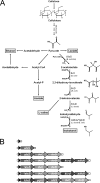Metabolic engineering of Clostridium cellulolyticum for production of isobutanol from cellulose
- PMID: 21378054
- PMCID: PMC3126361
- DOI: 10.1128/AEM.02454-10
Metabolic engineering of Clostridium cellulolyticum for production of isobutanol from cellulose
Erratum in
- Appl Environ Microbiol. 2012 Oct;78(19):7171
Abstract
Producing biofuels directly from cellulose, known as consolidated bioprocessing, is believed to reduce costs substantially compared to a process in which cellulose degradation and fermentation to fuel are accomplished in separate steps. Here we present a metabolic engineering example for the development of a Clostridium cellulolyticum strain for isobutanol synthesis directly from cellulose. This strategy exploits the host's natural cellulolytic activity and the amino acid biosynthesis pathway and diverts its 2-keto acid intermediates toward alcohol synthesis. Specifically, we have demonstrated the first production of isobutanol to approximately 660 mg/liter from crystalline cellulose by using this microorganism.
Figures





References
-
- Alvira P., Tomas-Pejo E., Ballesteros M., Negro M. J. 2010. Pretreatment technologies for an efficient bioethanol production process based on enzymatic hydrolysis: a review. Bioresour. Technol. 101:4851–4861 - PubMed
-
- Atsumi S., Hanai T., Liao J. C. 2008. Non-fermentative pathways for synthesis of branched-chain higher alcohols as biofuels. Nature 451:86–89 - PubMed
-
- Atsumi S., Higashide W., Liao J. C. 2009. Direct photosynthetic recycling of carbon dioxide to isobutyraldehyde. Nat. Biotechnol. 27:1177–1180 - PubMed
-
- Brestic-Goachet N., Gunasekaran P., Cami B., Baratti J. C. 1989. Transfer and expression of an Erwinia chrysanthemi cellulase gene in Zymomonas mobilis. J. Gen. Microbiol. 135:893–902
-
- Cascone R. 2008. Biobutanol—a replacement for bioethanol? Chem. Eng. Prog. 104:S4–S9
Publication types
MeSH terms
Substances
LinkOut - more resources
Full Text Sources
Other Literature Sources

